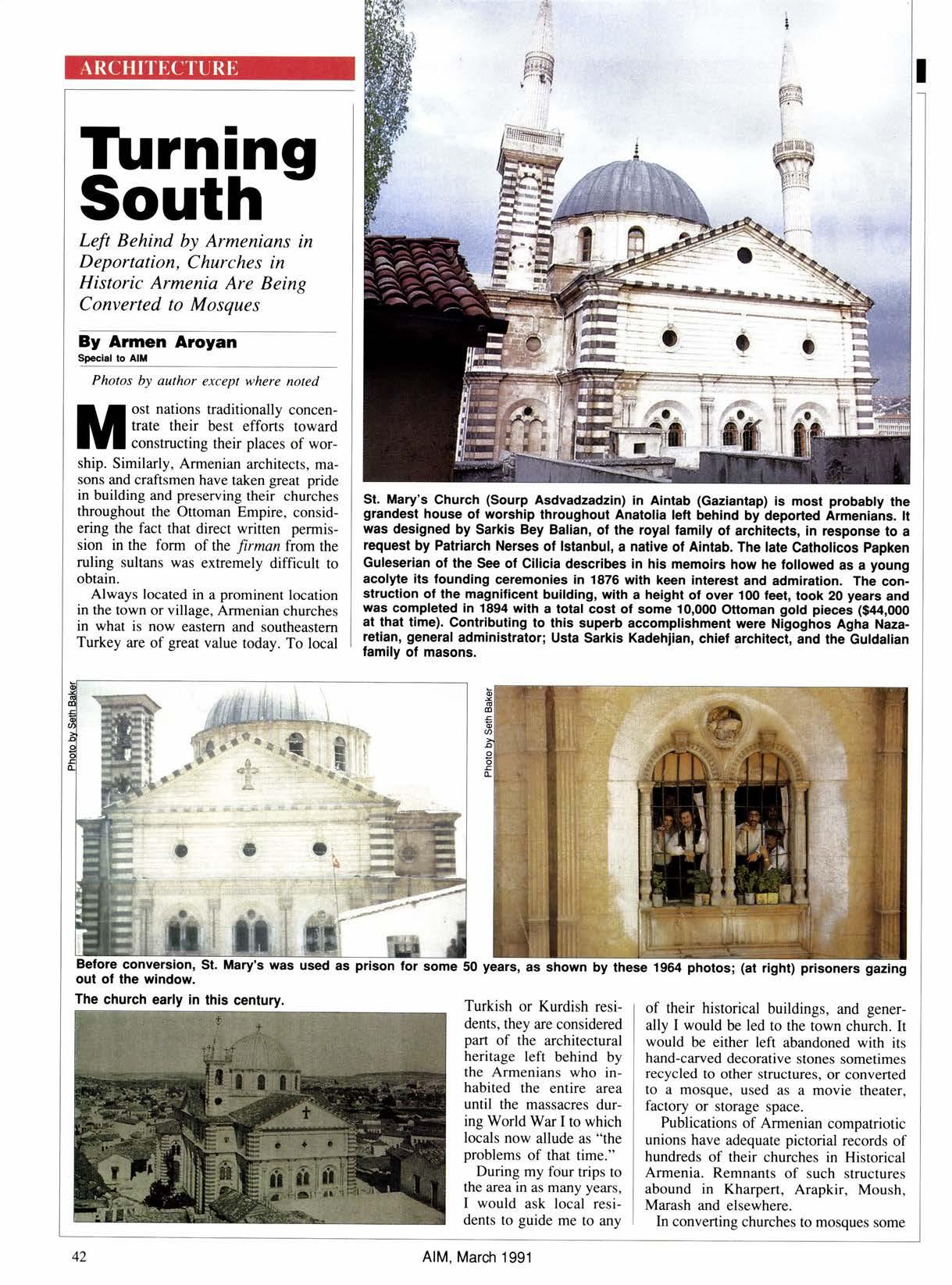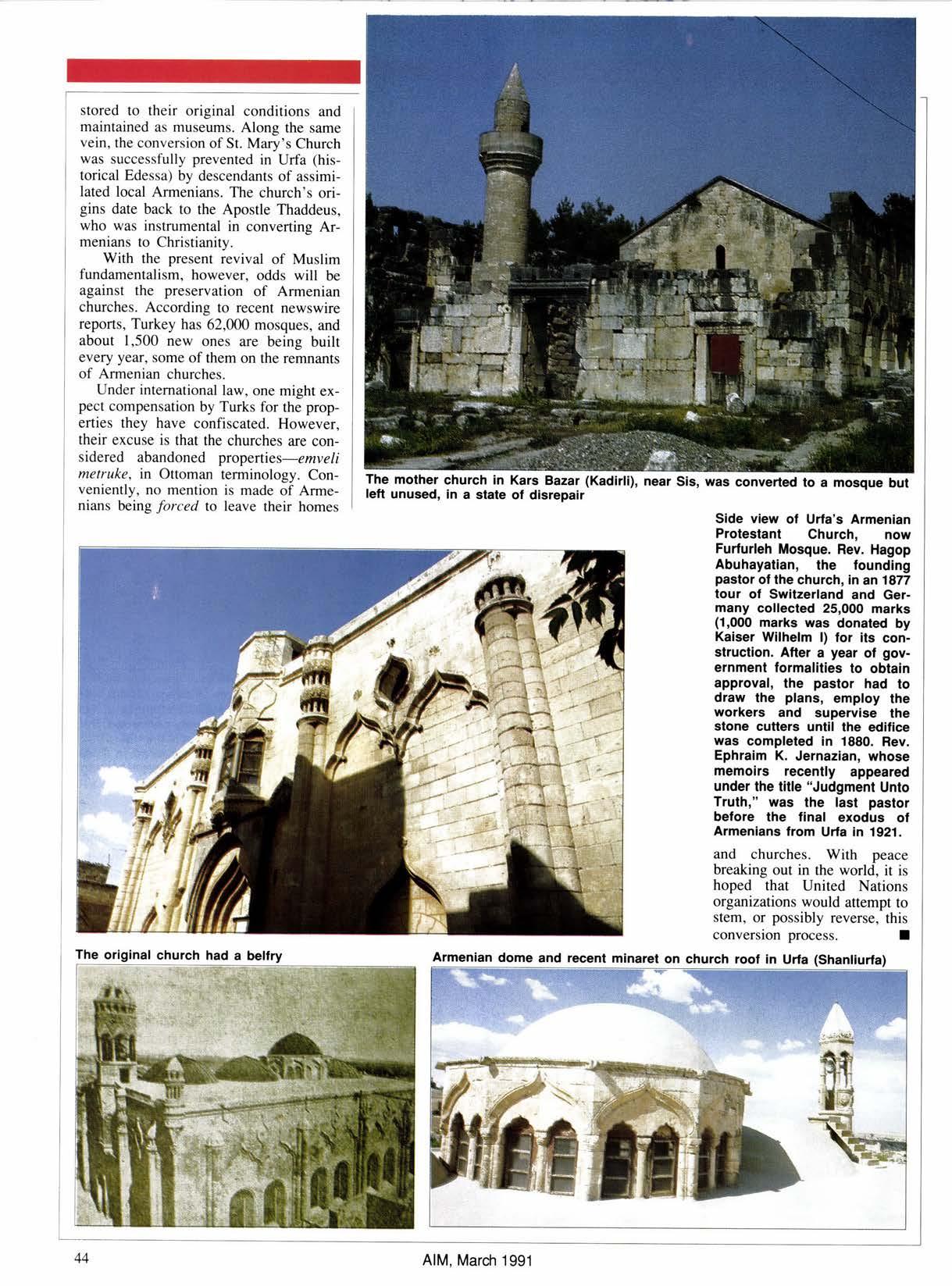
4 minute read
TUrninq South =
Left Behind by Armenians in Deportation, Churches in Historic Armenia Are Being Converted to Mosques
By Armen Aroyan
Advertisement
Spoclsl to AIU
Photos by author except where noted ost nations traditionally concentrate their best efforts toward constructing their places of worship. Similarly, Armenian architects, masons and craftsmen have taken great pride in building and preserving their churches throughout the Ottoman Empire, considering the fact that direct written permission in the form of the firman from the ruling sultans was extremely difficult to obtain.
Always located in a prominent location in the town or village, Armenian churches in what is now eastern and southeastem Turkey are of great value today. To local
St. Mary's Church (Sourp Asdvadzadzin) in Aintab (Gazaantap) is most probably the grandest house of worship throughout Anatolla left behind by deported Armenians. lt was designed by Sarkis Bey Balian, of the royal lamily of architects, in response to a request by Patriarch Nerses ol lstanbul, a native ol Aintab. The late Catholicos Papken Guleserian of the see of cilicia describes in his memoirs how he followed as a young acolyte its lounding ceremonies in 1876 with keen interest and admiration. The construction ol the magniticent building, with a helght ol over 1(X) feet, took 20 years and was completed in 1894 wlth a total cost of some 10,(XX) Ottoman gold pieces ($44,OOO at that time). Contributing to this superb accomplishment were Nlgoghos Agha Nazaretian, general administrator; usta sarkis Kadehjian, chiel architect, and the Guldalian lamlly ol masons.
St. Mary's was used as prison for some 50 years, as shown by these 1964 photos; (at right) prisoners gazing
Turkish or Kurdish residents, they are considered part of the architectural heritage left behind by the Armenians who inhabited the entire area until the massacres during World War I to which locals now allude as "the problems of that time."
During my four trips to the area in as many years, I would ask local residents to guide me to any of their historical buildings, and generally I would be led to the town church. It would be either left abandoned with its hand-carved decorative stones sometimes recycled to other structures, or converted to a mosque, used as a movie theater, factory or storage space.
Publications of Armenian compatriotic unions have adequate pictorial records of hundreds of their churches in Historical Armenia. Remnants of such structures abound in Kharpert, Arapkir, Moush, Marash and elsewhere.
In converting churches to mosques some
The Armenlan Protestant Church, over the toothills ol Musa Dagh ln Bitias, was built in 1881, durlng the pastorshlp ol Rev. Hall ilanug Nlgoghosian. The plane ltee (chlnar or sossr) to the teft was planted during the tounding ceremonies. ln 1915, the pastor ol the church, Fev. Harutiun Nohkudian (later changed to Serian), was deported with Of famllles lrom Bitlas, while Rev. Dikran Antreassian, in exile from his Pastorate an Zeytun, wes one ol the fearless leaders ol the self{efense ol Musa Ler immortallzed in Franz Werlel's novel. Antreassian later returned to pastor this church intermittently during the '2Os and '30s. Rev. Garabed Tilklan, now a resident of Encino, Californla' fondly remembers the lmpresslve ordinatlon ceremonaes in this church in 1936 ot lts last pastor, Rev. Aram Hadidlan, a native of Aantab.
The Church ol Holy Wisdom (Sourp So' phia) in Darson (Tarsus), birthplace ol the Apostle St. Paul. Presently converted, the church is where the first Armenian King ol Cilicia, Levon l,,was crowned in 1199 by the archbishop..of Mainz representing Pope Celestine lll and anointed by Catholicos Krikor Apirat.' problems arise for the Turkish architect. Since Armenian altars face east, the building must be turned sideways, figuratively, for Islamic worship, as mosque mihrabs or altars are required to face south, toward Mecca in Saudi Arabia. Therefore, the major Armenian entranceway becomes a side entrance and is sometimes partially closed up with cement blocks. A church side entrance on the north side becomes the Muslim main entrance. Also, in adding on one or two minarets, many times little attempt is made to match the Armenian stonework. Much cruder masonry skills sometimes result in painted bricks that do not conform to the existing architecture.
I have found several enlightened Turks who disapprove of the conversion of these churches; for them, tacking on minarets is a cheap way to create a mosque. Calling it cultural genocide, they feel there already exists a sufficient number of mosques, which are sparsely attended. They prefer to see Armenian churches re-

ffil+F;rr+gp;1iqff'-
stored to thcir original condilions and maintained as museums. Along the same vein. the conversion of St. Mary's Church was successl'ully prevented in Urfa (historical Edessa) by descenclants ol assimilateci local Armenians. Thc church's origins date back to the Apostle Thadcleus, who u,as instrumental in converting Armenians to Christianity.

With the present revival of Muslim fundamentalism. however. odds will be against thc preservation of Armenian churche.. Ae cordinc l() recellt ncu swire reports, Turkey has 62.000 mosques. and about 1,500 new ones are being built everv vcar. some ol them on the remnants of Armenian churchcs.
L;ndcr international law. one might expect cornpensation b1, Turks lbr the properties they have confiscated. However. their excuse is that the churches are considered abandoned properties-enve/i melruke, in Ottorllan terminology. Convenicntly. no rncntion is ntade of Armenians being .fltrccd to leavc their homes
Side view of Urfa's Armenian Protestant Church, now Furlurleh Mosque. Rev. Hagop Abuhayatian, the founding pastor of the church, in an 1877 tour ol Switzerland and Germany collecied 25,000 marks (1,000 marks was donated by Kaiser Wilhelm l) lor its construction. After a year of government formalities to obtain approval, the pastor had to draw the plans, employ the workers and supervise the stone cutters until the edifice was completed in 1880. Rev. Ephraim K. Jernazian, whose memoirs recently appeared under the title "Judgment Unto Truth," was the last pastor belore the linal exodus of Armenians from Urla in 192'1. and churches. With peace breaking out in the world, it is hoped lhat Unircd Narions organizations would attempt to stem. or possibly reverse, this conversion process.










